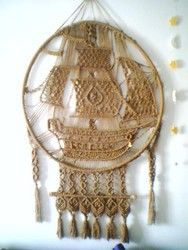마크라메
package.lua 80번째 줄에서 Lua 오류: module 'Module:Namespace detect/data' not found.
package.lua 80번째 줄에서 Lua 오류: module 'Module:Message box/localize' not found. 마크라메(Macramé)는 ()is a form of textile produced using knotting (rather than weaving or knitting) techniques.
The primary knots of macramé are the square knot (a variant of the reef knot) and forms of "hitching": various combinations of half hitches. It was long crafted by sailors, especially in elaborate or ornamental knotting forms, to decorate anything from knife handles to bottles to parts of ships.
Cavandoli macramé 는 짜기와 유사한 기하학적이고 형태가 자유로운 무늬를 형성하는 종류이다. Cavandoli 양식은 주로 single knot, double half-hitch knot 으로 마감된다. Reverse half hitches are sometimes used to maintain balance when working left and right halves of a balanced piece.
마크라메 기법으로 가죽, 천 벨트를 만들 수도 있다. 미국에서 대부분의 우정팔찌는 마크라메 기법을 이용하여 만들어져 학생들끼리 교환한다. 행상인들이 테마파크, 상점, 축제, 공공 장소에서 마크라메 장신구를 파는 것을 볼 수 있다.
역사[편집]

마크라메는 13세기에 "술" 을 의미하는 아랍 방적 용어 migramah 에서 유래하였다. 이는 북부 아프리카의 뜨거운 사막 지대에서 파리를 쫒는 데 사용하는 낙타와 말의 치렁치렁한 술을 지칭한다.
Another school of thought indicates that it comes from Turkish makrama, "napkin" or "towel", and was a way to secure the ends of pieces of weaving by using the excess thread and yarn along the top and bottom edges of loomed fabrics.
One of the earliest recorded uses of macramé-style knots as decoration appeared in the carvings of the Babylonians and Assyrians. Fringe-like plaiting and braiding adorned the costumes of the time and were captured in their stone statuary. Macramé traveled from north Africa to Spain with the Moors, and as a result of this conquest it spread, firstly to France, and then throughout Europe.
마크라메는 서반구에서는 13세기에 아랍 직공들에게서 유래했다고 알려져있다. 이 장인들은 남는 knotted the excess thread and yarn along the edges of hand-loomed fabrics into decorative fringes on bath towels, shawls, and veils. 스페인어 단어 macramé 는 "striped towel", "ornamental fringe" or "embroidered veil".을 의미한다고 알려진 아랍어 단어 miqramah (مقرمة) 에서 유래하였다고 여겨진다. 이 기법은 무어 인들이 스페인을 점령하면서 자연스레 스페인으로, 그 다음에는 이탈리아 특히 리구리아주로, 그리고는 유럽 전역으로 퍼져나갔다. 영국에는 17세기에 메리 2세 치세에 전파되었다. 메리 여왕은 마크라메 기법을 Queen Mary taught the art of macramé to her ladies-in-waiting.

Macramé was most popular in the Victorian era. Sylvia's Book of Macramé Lace (1882), a favorite, showed readers how "to work rich trimmings for black and coloured costumes, both for home wear, garden parties, seaside ramblings, and balls—fairylike adornments for household and underlinens ...". Most Victorian homes were adorned by this craft. Macramé was used to make household items such as tablecloths, bedspreads and curtains.[1]
선원들은 바다 위에서 남는 시간에 마크라메 작품을 만들었고, 상륙하고 나서 이를 팔거나 물물교환하였으며, 이리하여 중국이나 신대륙 등의 다른 지역에도 마크라메 기법이 퍼져나갔다. 19세기의 영국, 미국의 선원들은 마크라메 기법으로 해먹, 술, 벨트를 만들었다. 그들은 이 기법을 "square knotting" after the knot they used most frequently. 라고 불렀다. 선원들은 마크라메를 "McNamara's lace" 라고도 불렀다.[1]
Though the craze for macramé faded, it regained popularity during the 1970s as a means to make wall hangings, articles of clothing, bedspreads, small jean shorts, tablecloths, draperies, plant hangers and other furnishings. By the early 1980s macramé had again begun to fall out of fashion as a decoration trend.[2] Macramé jewelry has become popular among the American young and old crowd, starting in the early 1970s. Using mainly square knots and granny knots, this jewelry often features handmade glass beads and natural elements such as bone and shell. Necklaces, anklets and bracelets have become popular forms of macramé jewelry.[3]
재료[편집]

마크라메에 사용되는 재료는 목화 노끈, 아마포, 삼, 삼베, 가죽, 실 따위가 있다. Cords are identified by construction, such as a 3-ply cord, made of three lengths of fibre twisted together.[1] Jewelry is often made in combination of both the knots and various beads (glass, wooden, and so on), pendants or shells. Sometimes 'found' focal points are used for necklaces, such as rings or gemstones, either wire-wrapped to allow for securing or captured in a net-like array of intertwining overhand knots. A knotting board is often used to mount the cords for macramé work. Cords may be held in place using a C-clamp, straight pins, T-pins, U-pins, or upholstery pins.[1]
벽걸이장식, 창가리개와 같은 더 큰 장식품을 만들기 위해서 나무, 철근 지지대에서부터 만들어내기도 하는데, 수십 개의 cord를 퍼뜨려서 과정을 더 용이하게 할 수 있다. For smaller projects, push-pin boards are available specifically for macramé, although a simple corkboard works adequately. Many craft stores offer beginners' kits, work boards, beads and materials ranging in price for the casual hobbyist or ambitious craftsperson.
참고 문서[편집]
각주[편집]
외부 링크[편집]
| 위키미디어 공용에 관련된 미디어 분류가 있습니다. |
- Sylvia's Book of Macramé Lace by Sylvia (pseudonym), 1882.
- Macrame Instructions
- How To Macramé using Hemp
- Macramé
- 스크립트 오류: "citation/CS1" 모듈이 없습니다. Illustrations of various knots.
This article "마크라메" is from Wikipedia. The list of its authors can be seen in its historical and/or the page Edithistory:마크라메. Articles copied from Draft Namespace on Wikipedia could be seen on the Draft Namespace of Wikipedia and not main one.
